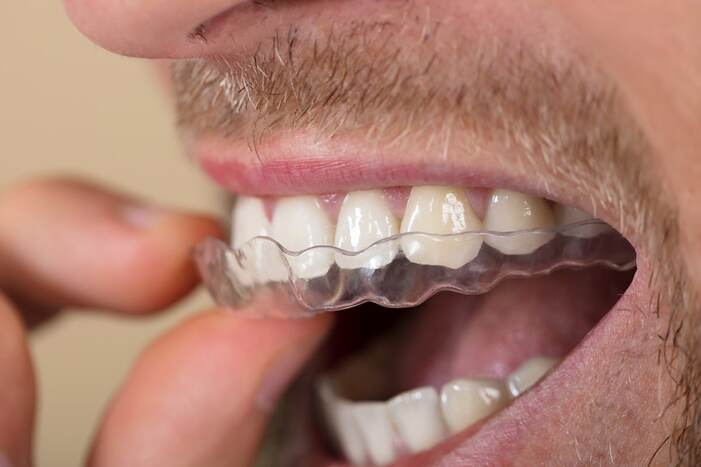
Invisalign retainers are an essential part of your orthodontic journey, ensuring that your teeth remain perfectly aligned after braces. Maintaining the cleanliness of your Invisalign retainer is crucial for both oral hygiene and the longevity of the retainer itself.
In this blog, we’ll guide you through the best practices for cleaning your Invisalign retainer, how to fix a cracked Invisalign retainer, and share some helpful tips to keep your retainer in excellent condition.
Whether you’re new to wearing retainers or looking for better ways to care for them, this comprehensive guide will help you maintain a bright and healthy smile.
Understanding Your Invisalign Retainer
What Is an Invisalign Retainer?
An Invisalign retainer is a clear, removable dental appliance designed to keep your teeth in their new positions after the removal of braces. Made from durable plastic, these retainers are custom-fitted to your teeth, ensuring a snug and comfortable fit.
Importance of Cleaning Your Invisalign Retainer
Properly cleaning your Invisalign retainer is essential for several reasons:
- Hygiene: Retainers can harbor bacteria, plaque, and tartar if not cleaned regularly, leading to bad breath and oral health issues.
- Appearance: Regular cleaning helps keep your retainer clear and free of stains.
- Durability: Proper care extends the lifespan of your retainer, ensuring it remains effective.
Daily Cleaning Routine for Your Invisalign Retainer
1. Rinse Immediately After Removal
Each time you remove your Invisalign retainer, rinse it under lukewarm water. This step helps remove saliva and any loose debris.
2. Brush Gently with a Soft Toothbrush
Using a soft-bristled toothbrush, gently brush your retainer. Avoid using toothpaste as it can be abrasive and cause scratches. Instead, use clear, fragrance-free liquid soap.
3. Soak in Retainer Cleaner
Once a day, soak your retainer in a retainer cleaner or Invisalign cleaning crystals. Follow the instructions on the product for the appropriate soaking time. These cleaners help eliminate bacteria and remove any buildup that brushing alone might miss.
4. Rinse and Store Properly
After soaking, rinse your retainer thoroughly with lukewarm water to remove any cleaning solution residue. Store your retainer in its case when not in use to protect it from damage and contamination.

Deep Cleaning Your Invisalign Retainer
1. Use a Baking Soda Solution
For a deeper clean, you can use a baking soda solution. Mix a tablespoon of baking soda with a cup of lukewarm water. Soak your retainer in this solution for about 15-20 minutes. Baking soda helps neutralize odors and remove stubborn stains.
2. Vinegar and Water Solution
Mix equal parts white vinegar and water and soak your retainer for 15-30 minutes. Vinegar is an excellent natural disinfectant and helps dissolve mineral deposits.
3. Hydrogen Peroxide Solution
A mixture of equal parts hydrogen peroxide and water can also be used for deep cleaning. Soak your retainer for about 30 minutes to disinfect and whiten it.
Avoiding Common Mistakes
1. Don’t Use Hot Water
Never use hot or boiling water to clean your retainer, as it can warp the plastic and ruin the fit.
2. Avoid Harsh Chemicals
Do not use bleach, alcohol, or other harsh chemicals on your retainer. These substances can damage the material and be harmful if ingested.
3. No Toothpaste or Hard Bristles
As mentioned earlier, avoid using toothpaste or hard-bristled brushes. These can scratch the surface of your retainer, making it more prone to harboring bacteria.

How to Fix a Cracked Invisalign Retainer
Identifying a Cracked Retainer
If you notice a crack in your Invisalign retainer, it’s important to address it promptly. A cracked retainer can lose its effectiveness and may even cause discomfort.
Temporary Fixes
For minor cracks, you can try the following temporary fixes until you can get a replacement:
- Use Denture Repair Kits: Some denture repair kits can temporarily mend small cracks. Follow the instructions carefully to avoid further damage.
- Avoid Using Super Glue: Super glue can be toxic and may cause further damage to your retainer.
Getting a Replacement
The best solution for a cracked retainer is to contact your orthodontist or dentist. They can assess the damage and provide a new custom-fitted retainer. Wearing a damaged retainer can impede your orthodontic progress, so it’s essential to get a replacement as soon as possible.
Maintaining Your Invisalign Retainer
1. Regular Check-Ups
Schedule regular check-ups with your orthodontist to ensure your retainer is in good condition and still fits properly. These visits are crucial for monitoring your progress and making any necessary adjustments.
2. Proper Storage
Always store your retainer in its case when not in use. This practice helps protect it from damage and keeps it clean. Make sure to clean the case regularly to prevent bacteria buildup.
3. Good Oral Hygiene
Maintaining good oral hygiene is vital for the health of your teeth and retainer. Brush and floss your teeth at least twice a day and use mouthwash to keep your mouth clean and fresh.
4. Avoiding Harmful Habits
- Don’t Eat or Drink with Your Retainer In: Eating or drinking anything other than water with your retainer in can cause stains and trap food particles.
- Avoid Chewing Gum: Chewing gum can stick to your retainer and be difficult to remove, potentially damaging it.
FAQs
1. How Often Should I Clean My Invisalign Retainer?
You should clean your retainer daily with a gentle brush and soak it in a retainer cleaner at least once a day. A deeper clean using solutions like baking soda, vinegar, or hydrogen peroxide should be done weekly.
2. Can I Use Toothpaste to Clean My Retainer?
No, toothpaste is abrasive and can scratch the surface of your retainer, making it more susceptible to bacteria buildup. Use clear, fragrance-free liquid soap instead.
3. What Should I Do If My Retainer Smells Bad?
A bad smell indicates that your retainer needs more frequent or thorough cleaning. Soak it in a retainer cleaner or a vinegar solution to remove odors. Ensure you rinse it thoroughly before wearing it again.
4. How Do I Know When to Replace My Retainer?
Signs that it’s time to replace your retainer include visible cracks, warping, or if it no longer fits properly. Regular check-ups with your orthodontist can help determine when you need a new retainer.
5. Can I Use Mouthwash to Clean My Retainer?
While mouthwash can disinfect, it often contains alcohol, which can be harsh on your retainer. If you want to use mouthwash, ensure it is alcohol-free and rinse your retainer thoroughly afterward.
Conclusion
Cleaning your Invisalign retainer is a vital part of your orthodontic care routine. By following the steps outlined in this guide, you can keep your retainer clean, clear, and effective.
Regular maintenance not only ensures the longevity of your retainer but also contributes to your overall oral health.
Remember to avoid common cleaning mistakes, and if your retainer becomes damaged, seek professional help for a replacement. With proper care, your Invisalign retainer will help you maintain a beautifully aligned smile for years to come.


